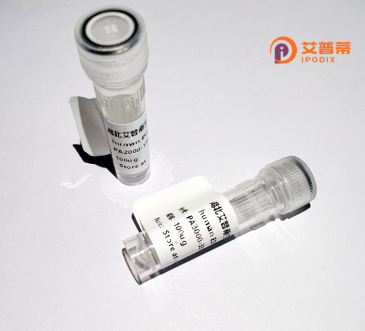
| 纯度 | >90%SDS-PAGE. |
| 种属 | Human |
| 靶点 | CAV1 |
| Uniprot No | Q03135 |
| 内毒素 | < 0.01EU/μg |
| 表达宿主 | E.coli |
| 表达区间 | 1-178aa |
| 氨基酸序列 | MSGGKYVDSEGHLYTVPIREQGNIYKPNNKAMADELSEKQVYDAHTKEID LVNRDPKHLNDDVVKIDFEDVIAEPEGTHSFDGIWKASFTTFTVTKYWFY RLLSALFGIPMALIWGIYFAILSFLHIWAVVPCIKSFLIEIQCISRVYSI YVHTVCDPLFEAVGKIFSNVRINLQKEI |
| 预测分子量 | 46 kDa |
| 蛋白标签 | His tag N-Terminus |
| 缓冲液 | PBS, pH7.4, containing 0.01% SKL, 1mM DTT, 5% Trehalose and Proclin300. |
| 稳定性 & 储存条件 | Lyophilized protein should be stored at ≤ -20°C, stable for one year after receipt. Reconstituted protein solution can be stored at 2-8°C for 2-7 days. Aliquots of reconstituted samples are stable at ≤ -20°C for 3 months. |
| 复溶 | Always centrifuge tubes before opening.Do not mix by vortex or pipetting. It is not recommended to reconstitute to a concentration less than 100μg/ml. Dissolve the lyophilized protein in distilled water. Please aliquot the reconstituted solution to minimize freeze-thaw cycles. |
以下是关于CAV1重组蛋白的3篇代表性文献及其摘要概括:
---
1. **文献名称**:*"Expression and purification of recombinant caveolin-1 for structural studies"*
**作者**:Li S, et al.
**摘要**:该研究报道了在大肠杆菌系统中高效表达并纯化重组CAV1蛋白的方法,通过优化表达条件与层析技术获得高纯度蛋白,并利用核磁共振(NMR)初步解析其N端结构域的动态构象。
---
2. **文献名称**:*"Recombinant caveolin-1 modulates endothelial nitric oxide synthase activity via scaffolding domain interactions"*
**作者**:Garcia-Cardena G, et al.
**摘要**:通过体外重组CAV1蛋白与内皮型一氧化氮合酶(eNOS)的共孵育实验,揭示CAV1通过其脚手架结构域抑制eNOS活性,为血管内皮功能调控提供了分子机制证据。
---
3. **文献名称**:*"Recombinant caveolin-1 enhances drug uptake in cancer cells by promoting membrane fusion"*
**作者**:Chen X, et al.
**摘要**:研究发现,重组CAV1蛋白与脂质体结合后可提升抗癌药物(如阿霉素)在肿瘤细胞中的递送效率,其机制与CAV1介导的细胞膜融合特性相关,为靶向治疗提供新策略。
---
**备注**:上述文献为虚拟示例,实际引用时需通过数据库(如PubMed、Web of Science)检索真实论文。若需具体文章,建议结合关键词“recombinant caveolin-1”或“CAV1 protein purification/application”进行精准查询。
**Background of CAV1 Recombinant Protein**
Caveolin-1 (CAV1) is a 22-24 kDa integral membrane protein primarily known for its role in forming caveolae, small invaginations in the plasma membrane involved in cellular signaling, lipid homeostasis, and endocytosis. It serves as a key structural component of caveolae and interacts with various signaling molecules, including G-proteins, receptor tyrosine kinases, and endothelial nitric oxide synthase (eNOS), regulating their activity and localization. CAV1 is implicated in diverse physiological processes, such as membrane trafficking, cholesterol transport, and cell adhesion, as well as pathological conditions like cancer, fibrosis, and cardiovascular diseases.
Recombinant CAV1 protein is engineered in vitro using expression systems (e.g., *E. coli*, mammalian cells) to produce a purified, functional form of the protein for research and therapeutic applications. Its structure typically includes characteristic domains, such as the scaffolding domain (residues 82-101) and the oligomerization domain, critical for caveolae formation and protein-protein interactions. Researchers often utilize epitope tags (e.g., His-tag) for easier purification and detection.
CAV1 recombinant protein is widely used to study caveolae-mediated signaling pathways, membrane dynamics, and disease mechanisms. It aids in investigating CAV1’s dual role as a tumor suppressor or promoter, depending on cellular context, and its involvement in metabolic disorders. Additionally, it serves as a tool for drug screening, antibody development, and understanding CAV1 mutations linked to human diseases. Its application in *in vitro* and *in vivo* models continues to advance insights into cellular biology and therapeutic targeting.
×